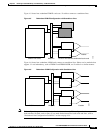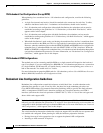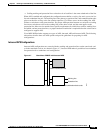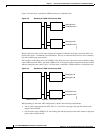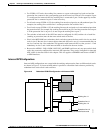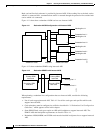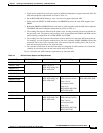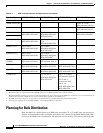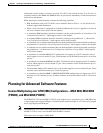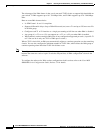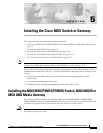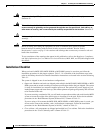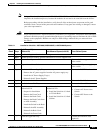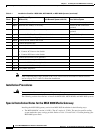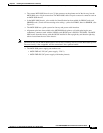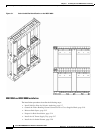
4-21
Cisco MGX 8800/8900 Series Hardware Installation Guide
Releases 2 - 5.2, Part Number OL-4545-01, Rev. H0, May 2006
Chapter 4 Planning for Card Redundancy, Line Redundancy, and Bulk Distribution
Planning for Advanced Software Features
distribution is that it enables a switch to use fewer T3 or OC-3 lines instead of many T1 or E1 lines. A
secondary benefit is that SRME and SRME/B cards can provide line redundancy to cards that otherwise
could not use that feature.
When planning for bulk distribution, consider the following guidelines:
• Bulk distribution works with T1 and E1 service modules. Refer to Table 4-1 to see which service
modules support bulk distribution.
• When a service module is configured to use bulk distribution, this service is applied to all lines on
the service module and no back cards are required.
• A standalone SRM installation should be installed according to the guidelines in “Standalone Card
Configuration Guidelines,” which appears earlier in this chapter.
• A redundant SRM installation should be installed according to the guidelines in “1:1 Redundant
Card Configuration Guidelines,” which appears earlier in this chapter.
• A standalone service module installation that uses bulk distribution should be installed according to
the guidelines in “Standalone Card Configuration Guidelines,” which appears earlier in this chapter.
• A redundant service module installation that uses bulk distribution should be installed according to
the guidelines in “1:N Redundant Card Configuration Guidelines (Except RPM),” which appears
earlier in this chapter.
• A standalone or redundant SRM-3T3/C configuration can support up to 80 T1 channels, each of
which supports a service module T1 port. These channels can be divided between up to 10 card slots
per bay.
• A standalone or redundant SRME/B with a BNC-3T3-M back card can support up to 84 T1 channels,
each of which supports a service module T1 port. These channels can be divided between up to 11
card slots per bay.
• The maximum number of E1 channels is 63, each of which supports a service module E1 port. These
channels can be divided between up to 8 card slots per bay.
• A standalone or redundant SRME or SRME/B SONET/SDH configuration can support up to 84 T1
channels or 63 E1 channels per bay, and these channels can be divided between all 12 card slots in
the bay.
Planning for Advanced Software Features
Inverse Multiplexing over ATM (IMA) Configurations—MGX 8830, MGX 8850
(PXM45), and MGX 8850 (PXM1E)
The PXM1E-16-T1E1 and AXSM-32-T1E1-E cards support inverse multiplexing over ATM (IMA) into
a single, higher-speed logical ATM port. The IMA feature enables multiple T1 or E1 lines to be grouped
into a single high-speed ATM port.
Note The PXM1E-16-T1E1 card is used in MGX 8830 and MGX 8850 (PXM45) switches; the
AXSM-32-T1E1-E card is used in MGX 8850 (PXM45) switches.
This feature does not apply to MGX 8950.



